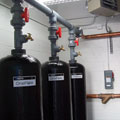
Hahn Family Wines, located on the Monterey peninsula in California, solves its water quality dilemma
through the implementation of salt-free treatment. Photos courtesy of Hahn
Winery
The Monterey peninsula is considered by some to be one of the California coastline’s finest areas. Within it lies the Santa Lucia Highlands, home to theHahn family’s vineyard estate.
It was here in the 1970s thatNicolaus Hahnand his wife,Gaby, discovered a love for California wines. Two years later in Monterey County – an area with the most varied climatic conditions of any region in California – they purchased two ranches on which to start a winery. Today, Hahn brand wines are among the finest produced in the region.
Though climatic conditions are ideal for the formation of perfect grapes, the water that comes from under the ground – which they use only for heat cleaning and sterilization of fermenting barrels and bottles – is about as ornery as it gets.
The subterranean water supply there is rich in scale and produces minerals. Gritty deposits collect and become troublesome with the application of heat. Yet hot water is a commodity they need plenty of.
Winery Goes Green
Managers of Hahn Family Wines sought out and made arrangements for the installation of an environmentally friendly water treatment system for the winery. Today, Hahn Family Wines enjoys the fruits of environmental responsibility through the use of salt-free water treatment.Previously, Hahn managers applied the use of salt-based water softening for critical boiler treatment applications. The winery’s goal was to eliminate chemicals, salts and waste discharge while ensuring the highest quality water.
To eliminate salt in the treatment of the main water supply for the winery, the family commissioned the installation of a TAC (template-assisted crystallization) central treatment system.

The massive vineyard previously applied
the use of salt-based water softening for critical boiler treatment applications,
but wanted to eliminate chemicals, sales and waste discharge while ensuring the
highest quality of water.
Physical Water Treatment
TAC falls into a category of water treatment often referred to as physical water treatment, or PWT. The driving force for physical water treatment in the marketplace was to offer more environmentally friendly technology.The primary goals of PWT are to:
-
1. Eliminate the use of chemical
additives;
2. Reduce or end discharge water, regenerates or wastewater;
3. Have zero pollution and disposal costs;
4. Minimize capital costs and ongoing maintenance.
TAC media start out as polymeric beads (resin) in the 20- to 40-mesh size range. Catalytically active sites or templates are “imprinted” or coated on the bead surface through a batch-coating process. The exact recipe, procedure and precision with which this is done is critical to manufacturing processes, assuring optimized media performance.
PWT technology works by changing the physical characteristics of the solution being treated, though with little or no change in the solution’s chemical composition. PWT is chiefly used to reduce the negative effects of water hardness (calcium carbonate) in plumbing systems, appliances and equipment (boilers, water heaters, dish washers, automotive and process washing equipment), valves and other components that generate or use heated water.
The vast majority offunctionalPWT devices work to promote hardness crystallization (mostly CaCO3) in the bulk solution, so it isn’t available to scale on downstream surfaces.
TAC technology influences the water solution at localized sites (on the media surface) such that hardness ions and their counter-ions (bicarbonate) combine to form inert nanometer-size “seed crystals.” Called nucleation, this is where dissolved molecules or ions dispersed throughout a solution start to gather to create clusters in the sub-micron size range.
The sum of the seeds provides an enormous area for preferential growth of remaining hardness ions still in solution. Making use of the phenomena of low-energy, heterogeneous transfer, when the remaining dissolved ions reach their solubility shift, they attach to the seed crystals and continue harmlessly downstream, eventually to be consumed or end up in the drain.
While closed-loop boiler systems technically do not qualify because there is no flow-to-drain, systems that incorporate a bottom blow-down with scheduled daily discharges have been successful in controlling scale while reducing or eliminating chemical additives.

Three Watts OneFlow tanks and outlet headers are installed inside the
winery’s mechanical room.
Know Your Chemistry
Although there is success in closed-loop and other applications that use chemicals downstream of the TAC treatment, it should be noted many common chemicals used in various water-using applications can actually work against the optimal performance of TAC systems.The most common area of concern is in commercial dishwashing where a wide variety of chemistries are used. If a targeted application also uses chemicals, be sure to do your homework to identify chemical compatibility with the water treatment.
TAC has an established scientific basis because it is the mechanism behind the growth of bone structures in the human body, called “bio-mineralization,” and is commonly used by pharmaceutical companies to create effective medicines.
TAC media was submitted to DVGW, the German Technical & Scientific Association for Water & Gas, whose standard W512 is considered the most rigorous accredited standard to certify PWT systems for scale reduction efficiency. The media achieved a scale prevention efficiency of more than 99% for both recirculation hot water (1998) and single-pass cold water (2006) protocols.
TAC media are always used in an up-flow design, which makes them not subject to low-flow channeling or high-flow pressure drops. The pressure drop as measured at peak flow rate is less than 4 psi. The media are subject to water chemistry limitations like other resins, such as chlorine, iron, manganese, tannins and pH.
The effective life of the TAC media is three years and is neither dependent of the volume of water nor the hardness level.
Water Scale: A Universal Dilemma
Building owners, property managers, chief engineers and facility maintenance personnel all face the same challenge in battling the ill effects of hard water. Protecting a commercial plumbing system from damaging lime deposits, called scale buildup, can bring considerable expense, both upfront and ongoing, to any commercial property.Ignoring scale control is never a good option because eventually the cost for repairs or replacement will offset the initial savings. For many years, the installation of commercial-grade water softeners was the only proven technology for scale protection.
Water softeners, however, present their own set of challenges. They require electricity to operate and take up precious space in already cramped mechanical rooms. They demand, and then waste, hundreds of gallons to drain during backwash and regeneration cycles and require salt or an even more expensive alternative (potassium chloride) to maintain performance. Clean water bears considerable cost coming in, and then must also be paid for as it makes its way into the waste-treatment stream.
TAC is a media-based scale control technology that can be used in point-of-entry applications to protect whole buildings on the hot and cold side. Selecting the appropriate-size TAC system is easily accomplished. Peak flow rate is all that is required to size a commercial system. Point-of-use systems also are offered to protect specific pieces of equipment that may be more prone to scale from water hardness.
Meanwhile, Back At The Winery
The system chosen by the winery requires no water-consuming discharge, while providing micron filtration and hard water scale protection.Well water is first filtered by two centrifugal micron filters to remove particulate matter. Microfiltered water is then passed through a hard water scale prevention system (Watts OneFlow). The scale prevention media operate catalytically without salt or chemicals and do not produce a waste stream.
“The (TAC) scale prevention is effective at preventing over 98% of the scale produced by the winery’s hard water,” Watts National Sales Manager for water treatmentSteve Callahannotes. “The only maintenance required on the system is a simple media replacement after two or three years of service.”
TAC technology enabled the facility to remove its salt-based water softeners, which preceded the boilers. The TAC system also provides treated water throughout the winery’s entire water distribution system.
“With Hahn Winery’s move to become more ecological, we looked at every facet of our environmental stewardship,” Hahn representativeEvelyn Poolstates. “We’re delighted with our effort to become sustainably certified in the vineyards. Eliminating salt-based softeners, while adding new (TAC) scale prevention is a real boost to our sense of environmental responsibility.”

Photo courtesy of Embassy Suites
Hotel Weighs Options
In 2005,Gregg Josey, chief engineer at Embassy Suites in Tempe, Ariz., was faced with a similar dilemma as the Hahns.Josey considered replacing the hotel’s failing water softener installed years earlier. Josey researched TAC technology, discovering it would be less costly upfront and would save the facility nearly 70% in operating costs, mostly in salt and water purchases and discharge costs.
The hotel had numerous points of entry for municipally supplied water, and the water hardness measured between 12 and 14 grains per gallon. As a result, water treatment was practical only on the “hot side” of the plumbing system.
The property needed to treat water for the domestic water boiler, heat exchange surfaces and numerous point-of-use tempering valves - essentially the entire domestic hot water distribution system. Another key concern at the hotel was the many showerheads, one for each of the 224 rooms.
“Calcium deposits within the showerheads at many hotels often look filthy and frequently are the cause of recurring maintenance issues,” explains Callahan, who visited the hotel in 2005 to properly size the TAC treatment system for the hotel.
“Water flow to showerheads is restricted by the deposits and, in addition to that, front desk personnel at hotels get calls – often at night or early in the morning – from guests who complain about unsightly, dirty-looking deposits. They think the maids aren’t doing their jobs, when in reality the problem stems from insufficient water treatment. The technology is available to end all of that.”
Ultimately, Josey decided to remove the old water treatment system and replaced it with new TAC scale control technology.
Josey has now enjoyed maintenance-free scale protection for five years.
“A simple media replacement, once every three years is all that’s needed to keep the system running scale-free,” he states.
Today, the hotel’s metered water use and wastewater discharge are substantially reduced and it no longer funds the routine maintenance and replenishing tasks it once had with a salt-based system.
“We never regretted the move,” Josey says.